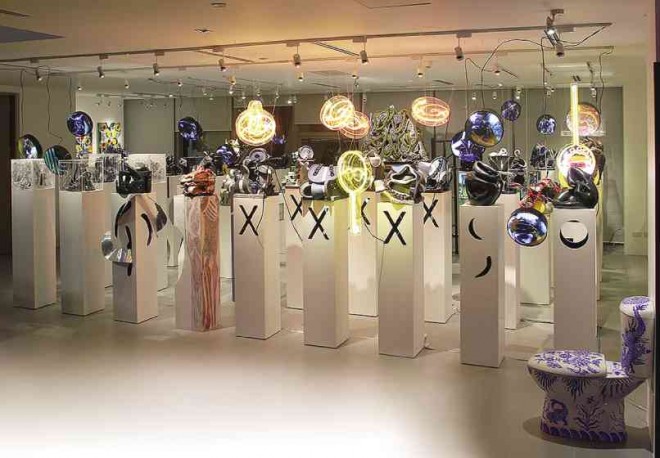
Imagine it’s the 22nd millennium. An excavation uncovers vestiges of a city in the early 21st century, including its master plan.
The shoes, chains, teapots and saucers are treated by archaeologists as ancient relics and fixations of that era.
Carlo Calma’s latest output, “Obsession and Fetishes,” is not only an exhibit of experimental artworks, it is also the architect-artist’s quirky proposal on how we live.
To be viewed at the Clipp House in Taguig, the exhibit has two parts: Calma’s 65-piece installation of the city and its embedded artifacts; and the works of Leeroy New and other artists and architects dealing with space and parts of the house.
The result is a visual overload. One goes through the network of pedestals and objects to make sense of the work slowly.
Grotto as decor
Calma’s urban manifesto fuses his surrealistic style with elements of pop culture.
Not one to be boxed in as architect, Calma is a sculptor, video director and performance artist, aside from being a restaurateur. The installations reflect Calma’s unbridled imagination, expressing what comes to his mind without any edit.
True to surrealism, abstract sculptures are edgy and confident.
Parts of the body, a fundamental in surrealism, are parodied. For instance, a ceramic mound of lips is titled “Scale of Speech.” The silhouettes could also be viewed as the vagina.
In another display, hands and feet are chained under the silhouettes of Big Ben in London, where Calma had studied.
The crux of the installation is how Calma pushes the boundaries of architecture concepts and transforms them into experimental art. One of his theses is the use of space and his fascination with cavernous spaces.
The focal point is a monitor, displayed like an altar under a porcelain abstract polka-dot grotto, which lends an absurdly religious allure. He proposes that the grotto, although surreal, is not just for devotion but can also be decorative. (He created a larger metal “grotto” with pebble flooring that can be displayed by the poolside.)
The monitor runs the video that Calma produced, wrote, directed, edited and starred in. It shows seemingly unrelated images of Calma in yellow coat digging the earth, his hands amid earthenware. His psychedelic body paint by makeup artist Xeng Zulueta blends with the patterns of his green pedestal.
“I wanted to create several characters to show my complexity as an architect and multidimensional artist,” he says.
“My wearing a green tattoo and writhing beside the green pedestal is about bodies and how you choreograph people—how they enter the space and how they are oriented toward it. All of these interest me when I build spaces. I ask myself how I can fool people to make them laugh, or to excite them. These are experiential spaces of what I want to create.
“The snippets on the video are abstract. I want to make the mundane and everyday objects interesting,” he says.
Generic skyline
At the perimeter of the installation, acrylic silhouettes of the cities where Calma had lived—Manila, London and San Francisco—hover over the metal abstractions of twisted tubes, symbolic of the city and its underground plumbing.
The Manila skyline looks so generic, lacking in architecture icons, unlike the cutouts of San Francisco’s Transamerica Pyramid and Golden Gate Bridge, and London’s Big Ben and the London Eye.
Calma also explores the concept of automation in smart homes and surveillance equipment. A neon peephole floats above a chained sculpture whose pedestal has a button. Once you press it, a voice is activated, “Who are you looking at?”
“Automation isn’t popular here because we have maids. Technology is good but not yet applicable here. If you treat this concept as art, it becomes cooler,” says Calma.
There is humor in his exploration of scale. One installation has a tiny abstract rat dwarfed by distorted teapots, cups and saucers. This is Calma’s take on the rat’s perspective of our everyday objects.
“For a rodent, the scale of the world is larger than us. Scale creates drama. The larger it is, the more dramatic,” he says.
He explores perspective and scale in another installation which shows montages of a city viewed from a top angle and holes with rats in underground tunnels.
“The city has an underground life, even the Vatican. These are things that are not seen but they’re there,” he says.
Below the acrylic-covered montages are sculptures of rodents’ heads caught in an assemblage of chains, jars and everyday objects which Calma considers as the eponymous fetishes and obsessions.
Interpreting construction materials and supplies, Calma clusters hammers into a forest and photographs a paintbrush using special effects to create an abstract image for a light box.
Exploring the concept of artisanship, he elevates the hollow block using ceramic instead of concrete, produced manually in Pampanga. Calma explains that their patterned holes are used for ventilation.
At the entrance, piles of hollow blocks with different patterns jolt the viewers, as if they were entering a construction site.
On a corner, these blocks hold up a ceramic sculpture of images from “Machete,” a local comics hero, as Calma’s homage to Pinoy pop culture.
Other artists express their fascination with home objects and turn them into stunning visual puns.
Jia Estrella plays with the idea of ceramics by turning a toilet into a patterned art piece similar to the Oriental blue-and-white pottery.
Architect Anton del Castillo builds a door which can be installed anywhere.
Romeo Lee produces a clock which doubles as plaque with LED light bulbs.
Calma says the installations invite all kinds of interpretations.
For all their cryptic qualities, these objects serve a practical purpose. When Calma furnishes houses of clients, he has a tough time finding the right accessories to complement his idiosyncratic style.
In the end, these works will accentuate homes, not only to express an unconventional viewpoint but also to show Filipino artisanship.
“Obsession and Fetishes” will run until Dec. 22 at the penthouse of the Clipp House, 39th cor. 11th Avenues, Bonifacio Global City.